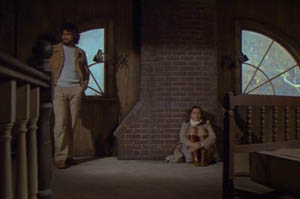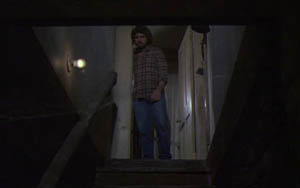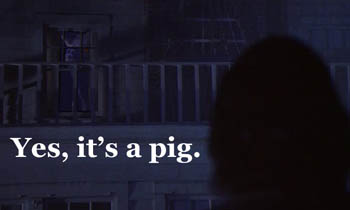|
 ...didn't really happen. Despite its status as a legendary "true" haunting story, the supernatural shenanigans at the Lutzes' briefly-owned family home were an admitted hoax cooked up by the family together with the lawyer for Butch DeFeo, the real-life murderer whose killing of his family had left the house with a nasty local reputation. The seventies were indeed a magical time, when legal representatives actually believed a "devil made him do it" plea could potentially secure a convicted murderer a new trial (though thankfully, reason be praised, it didn't). The Lutzes, on the other hand, made tons of money by exploiting the story and made the house a nightmare of another sort for subsequent owners, who were beset not by spirits from beyond, but by throngs of looky-loos who flocked to the famous lot and made a quiet, private life at the location impossible. None of this, however, is the real problem, at least insofar as the film is concerned. The basic story is well-known, and not exactly brimming with originality: a family moves into a house with a bloody history, and shortly thereafter begins to experience all sorts of inexplicable phenomena, none of it pleasant. Doors lock themselves or rip themselves loose, eyes are seen staring into windows, masses of flies collect in certain rooms, and voices demand that priests "GET OUT," which by my reckoning is a pretty reasonable demand, if not one typically expected to come directly from the property itself. There's a hidden basement room, and a cold spot that seems to selectively follow the father throughout the house, there's the sudden appearance of an imaginary friend in their daughter's life and an oppressive sense of evil that falls upon most visitors. It is, in short, a pastiche of every haunted-house cliché on the books, gussied up with the sensational claim that the story is based on true events. George Lutz looked just like the murderer! (He didn't.) The priest went blind! (He didn't.) Ultimately, though, issues of truth are irrelevant. The Exorcist also claimed a truthful pedigree, though it was likewise fabricated. It is, however, an engrossing and well-made film with a broadly-understandable, allegorical meaning: the helplessness of parents faced with a sick or dying child whom they cannot help. William Peter Blatty's silly insistence that the story is based in fact doesn't derail its success as a piece of drama, and this is Amityville's real stumblingblock. 
The simple and disappointing fact is that this is just not a very good movie. As an ostensible horror film, its nearly-nonexistent scares are a real handicap, and what scares it does possess are of the dimestore-cheap variety, such as the abrupt appearance of a yowling cat who is mixed twice as loudly as the rest of the soundtrack. The narrative is horribly disjointed; characters appear and disappear at random and often serve no purpose. The priest's story goes nowhere and never rejoins the main plotline. A cop character is even more poorly served, providing the editor with something to occasionally break up the family scenes, and doing nothing of a helpful nature at all. The Lutzes' two young sons vanish entirely for the middle hour of the movie. Perhaps the best example of the film's clumsiness is embodied by the old wooden door George finds in the basement early on-in total defiance of what any respectable haunted house flick ought to do, the door is never opened. No, the secret basement room is eventually found by breaking through the stone wall. By the time the viewer reaches the scene where a homicidally possessed George sees a glowing-eyed, floating purple pig looking out of an upstairs window, he or she will likely be torn between whether the filmmakers were incompetent in assuming that the low light and quick shots would hide the nature of some old prop grabbed on the cheap, or if they were completely silly folk who actually wanted you recognize the evil entity as a floating purple pig. Neither option, unfortunately, serves to provide scares over outright laughter. 
I do confess a sense of fondness for these old '70s horror flicks, which at least attempted to achieve their ends through atmosphere and suggestion instead of grotesque brutality, and which had to rely on practical means which felt far more unnerving for their realism; in the absence of CG effects, you had to really cover a real actor in real flies, and the audience knew it. But neither CGI nor its absence make up for the lack of a good script, and deprived of its true-story pretensions, there's regrettably little to recommend here. Except, admittedly, for the pig. The pig is a scream. Just not one of terror. -review by Matt Murray
|
|
||||||||